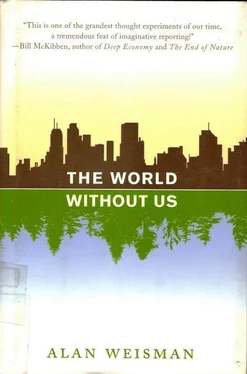Above all this are the flares, wedges of flame against a whitish sky, keeping all the organic chemistry in equilibrium by burning off pressures that build faster than all the monitoring gauges can regulate them. There are gauges that read the thickness of steel pipe at the right-angle bends where hot, corrosive fluids smash, to predict when they will fail. Anything that contains hot liquid traveling at high speeds can develop stress cracks, especially when the liquid is heavy crude, laden with metals and sulfur that can eat pipe walls.
All this equipment is controlled by computers—until something exceeds what the computer can correct. Then the flares kick in. Suppose, though, that a system’s pressures exceeded their capacity—or suppose nobody were around to notice the overload. Normally, somebody always is, around the clock. But what if human beings suddenly disappeared while the plant was still operating?
“You’d end up with a break in some vessel,” says Valero spokesman Fred Newhouse, a compact, congenial man with light brown skin and grizzled hair. “And probably a fire.” But at that point, Newhouse adds, fail-safe control valves up and downstream from the accident would automatically trip. “We measure pressure, flow, and temperature constantly. Any changes would isolate the problem so that fire couldn’t ripple from that unit to the next one.”
But what if no one were left to fight the flames? And what if all the power died, because no one was manning any of the coal, gas, and nuclear plants, or any of the hydroelectric dams from California to Tennessee, all of which funnel electrons through a Houston grid connection to keep the lights on in Texas City? And what if the automatic emergency generators ran out of diesel, so no signal tripped the shutoff valves?
Newhouse moves into the shadow of a cracking tower to consider this. After 26 years at Exxon, he really likes working for Valero. He’s proud of their clean record, especially compared to the BP plant across the road, which the EPA in 2006 named the nation’s worst polluter. The thought of all this incredible infrastructure out of control, torching itself, makes him wince.
“Okay. Everything would burn until all the hydrocarbon in the system was gone. But,” he insists, “it’s very unlikely that fire would spread beyond the property. The pipes that connect the Texas City refineries all have check valves to isolate one from another. So even when you see plants explode,” he says, gesturing across the road, “adjacent units aren’t damaged. Even if it’s a huge fire, fail-safe systems are in place.”
E.C. isn’t so sure. “Even on a normal operating day,” he says, “a petrochemical plant is a ticking time bomb.” A chemical plant and refinery inspector, he’s seen volatile light petroleum fractions do some interesting things on their way to becoming secondary petrochemicals. When light-end chemicals such as ethylene or acrylonitrile—a highly inflammable precursor of acrylic, hazardous to human nervous systems—are under high pressure, they often slip through ducts and find their way to adjacent units, or even adjacent refineries.
In the event that humans were gone tomorrow, he says, what would happen to petroleum refineries and chemical plants would depend on whether anybody bothered to flip some switches before departing.
“Supposing there’s time for a normal shutdown. High pressures would be brought down to low pressure. Boilers would be shut down, so temperature isn’t a problem. In the towers, the heavy bottoms would cake up into solid goop. They would be encased in vessels with steel inner layers, surrounded by Styrofoam or glass-fiber insulation, with an outer skin of sheet metal. Between those layers there’s often steel or copper tubing filled with water to control temperatures. So whatever is in them would be stable—until corrosion set in from the soft water.”
He rummages in a desk drawer, then closes it. “Absent any fire or explosion, light-end gases will dissipate into the air. Any sulfur by-product lying around will eventually dissolve and create acid rain. Ever see a Mexican refinery? There’re mountains of sulfur. Americans ship it off. Anyhow, refineries also have big tanks of hydrogen. Very volatile, but if they leaked, the hydrogen would float away. Unless lightning blew it up first.”
He laces his fingers behind his curly, graying brown hair and tilts back in his office chair. “Now that would get rid of lot of cement infrastructure right there.”
And if there were no time to shut down a plant, if humans were raptured off to heaven or another galaxy and left everything running?
He rocks forward. “At first, emergency power plants would kick in. They’re usually diesel. They would probably maintain stability until they depleted their fuel. Then you’d have high pressures and high temperatures. With no one to monitor controls or the computers, some reactions would run away and go boom. You would get a fire, and then a domino effect, since there’d be nothing to stop it. Even with emergency motors, water sprayers wouldn’t work, because there’d be no one to turn them on. Some relief valves would vent, but in a fire, a relief valve would just feed the flames.”
E.C. swivels completely in his chair. A marathoner, he wears jogging shorts and a sleeveless T-shirt. “All the pipes would be conduits for fires. You’d have gas going from one area to another. Normally, in emergencies you shut down the connections, but none of that would happen. Things would just spread from one facility to the next. That blaze could possibly go for weeks, ejecting stuff into the atmosphere.”
Another swivel, this time counterclockwise. “If this happened to every plant in world, imagine the amount of pollutants. Think of the Iraqi fires. Then multiply that, everywhere.”
In those Iraqi fires, Saddam Hussein blew up hundreds of wellheads, but sabotage isn’t always needed. Mere static electricity from fluids moving through pipes can spark ignition in natural-gas wells, or in oil wells pressurized with nitrogen to bubble up more petroleum. On the big flat screen in front of E.C, a blinking item on a list says that a Chocolate Bayou, Texas, plant that makes acrylonitrile was 2002’s biggest releaser of carcinogens in the United States.
“Look: If all the people left, a fire in a gas well would go until the gas pocket depleted. Usually, the ignition sources are wiring, or a pump. They’d be dead, but you’d still have static electricity or lightning. A well fire burns on the surface, since it needs air, but there would be no one to push it back and cap the wellhead. Huge pockets of gas in the Gulf of Mexico or Kuwait would maybe burn forever. A petrochemical plant wouldn’t go that long, because there’s not as much to burn. But imagine a runaway reaction with burning plants throwing up clouds of stuff like hydrogen cyanide. There would be a massive poisoning of the air in the Texas-Louisiana chemical alley. Follow the trade winds and see what happens.”
All those particulates in the atmosphere, he imagines, could create a mini chemical nuclear winter. “They would also release chlorinated compounds like dioxins and furans from burning plastics. And you’d get lead, chromium, and mercury attached to the soot. Europe and North America, with the biggest concentrations of refineries and chemical plants, would be the most contaminated. But the clouds would disperse through the world. The next generation of plants and animals, the ones that didn’t die, might need to mutate in ways that could impact evolution.”

ON THE NORTHERN edge of Texas City, in the long afternoon shadow of an ISP chemical plant, is a 2,000-acre wedge of original tall grass donated by Exxon-Mobil and now managed by The Nature Conservancy. It is the last remnant of what were 6 million acres of coastal prairie before petroleum arrived. Today, the Texas City Prairie Preserve is home to half of the 40 known remaining Attwater’s prairie chickens—considered the most endangered bird in North America until the controversial 2005 spotting in Arkansas of a lone ivory-billed woodpecker, a species hitherto believed extinct.
Читать дальше












